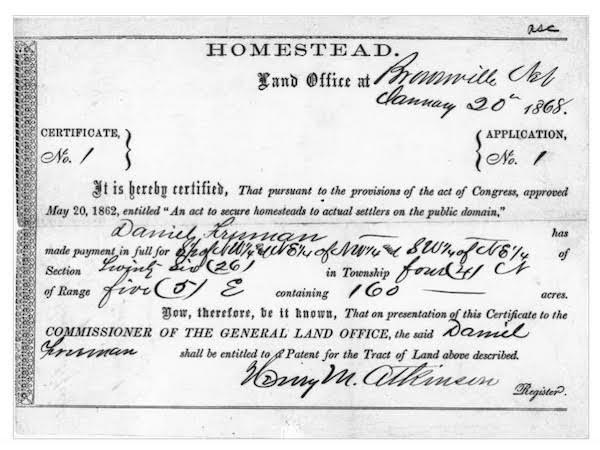It’s that time of year, and time to pay our remembrance to the “Homstead Act”. About 93 million Americans living today are the direct descendants of “homesteaders” those who filed claims under the “Homestead Act” which was signed on this weekend (May 20th) in 1862 by President Abraham Lincoln. Sadly, however, most of us have seen the recent stats showing the majority of the 33 million schoolchildren in this country today have never set foot on a farm. In fact, only two of every 100 Americans now live on a farm and less than 1% of the +300 million people in our country claim farming as their occupation. But many of us can trace our heritage and roots to parents, grandparents, or great-grandparents who spent their lives on a farm.
Beginning in 1863, the words “free land” became the driving force for many U.S. citizens, freed slaves, and hundreds of thousands of European immigrants to head West, after President Abraham Lincoln signed the “Homestead Act”. The act offered 160 acres of free land to any qualified homesteader who paid a modest filing fee, built a home, planted at least 10 acres of crops, and remained on his or her claim for at least five years.
Many historians have called this political move perhaps the most important act ever passed for the benefit of the American people. Arguably, it ultimately helped create the most productive agricultural economy the world has ever seen. It’s worth noting the legislation was very progressive as well, as the only personal requirement was that the homesteader is either the head of a family or 21 years of age, meaning any U.S. citizen, freed slave, new immigrant intending to become naturalized, single woman or people of all other races were eligible.
However, it was no small task to make it out in the western frontier where often the hardships and loneliness of prairie life proved too much for many. In fact, about 60% of approximately two million claims made under the Homestead Act were abandoned. Those who were able to grind it out were part of the 783,000 successful claims totaling 270 million acres. The largest homesteading states included… 151,600 homesteads in Montana, just over 118,000 in North Dakota, approximately 100,000 in each of the states of Colorado, Nebraska, Oklahoma, and South Dakota, and nearly 90,000 successful homesteads in Kansas. Hundreds of thousands of additional homesteads were claimed in states all across the US.
Surviving the elements, getting a house built, water source found, and starting a farm was just the beginning of the battle for most homesteaders. Those that did get a crop out of the ground soon found a new headwind, crazy high prices for transportation of grain to market. It didn’t take long for the homesteaders to form the Grange movement, which achieved government regulation of railroads. Similarly, in response to the drought of the late 1880s and low prices for grain, a tremendous groundswell of revolt produced the Farmer’s Alliance, followed by the political expression of the People’s Party, commonly known as the Populists, which the historian Lawrence Goodwyn calls “the largest democratic mass movement in American history.” It became clearly understood that the only way to deal with the new industrial monopolies of railroads and grain markets was through cooperation and co-ops that were soon to be born during that era.
Many argue that to this day, the Homestead Act remains the most comprehensive form of wealth redistribution that has ever taken place in America. Most view that term with disdain, whereas it had real meaning at that time when you had to produce to reap the benefit. I do not believe there are many other government programs that have so positively affected the growth of not only our nation but also lifted up individuals by allowing them to “prove up” the land they claimed, meaning each family had a responsibility to produce, to be a part of building out their own ground and a hand in helping to build our great nation despite the many ethnicities, colors, religious and political differences that existed. Unfortunately today, most of the government-sponsored programs are given more as gifts with no real commitment or ask in return.
I also believe that an overlooked outcome of the Homestead Act was its impact on fueling the Industrial Age, as the ever-increasing need for goods in the West inspired the invention, production, and delivery of those goods. As most of our ancestors experienced, farm equipment quickly moved from the use of hand tools to what we see today, making life on the farm somewhat easier with inventions like electricity, the appliances they ran, and indoor plumbing. It truly was a groundbreaking piece of progressive legislation with a legacy still felt today as it drove innovations across agriculture, transportation, and even social justice. For most today, the Homestead Act conjures images of the dusty plains and old west, but this couldn’t be farther from the truth. The Homestead Act was a true game-changer for our country. I wish our political leaders could come up with something today similar to the Homestead Act that would help provide an opportunity for those who need a hand-up but at the same time requires some real skin-in-the-game and hard work to make it happen.
Can you imagine the look on our homesteading ancestors’ faces who struggled to survive over a century ago if they were here to see what has since been accomplished in agriculture? Crazy to think about!
We all have our family stories of the struggles and hurdles that have been overcome by our ancestors to get the farm where it is today. The baton has been passed, now it’s our turn to make the tough decisions, make the changes necessary, and do the hard work that is ahead for our kids, their kids, and future generations. (Source: theamerican.mg, peoplesworld.org, grit.com)










